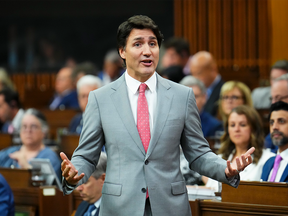The Trudeau government’s aggressive regulatory initiatives and tax-and-spend agenda have severely harmed Canada’s investment climate
Article content
Canada’s fourth-quarter GDP numbers were published last week, and while the economy barely dodged the technical definition of a recession, the figures again painted an ugly picture of Canadians’ economic well-being. Adjusted for inflation, GDP barely budged in Q4. Add the effect of population growth, and real GDP per capita declined for the sixth consecutive quarter. Relative to Q3:2015, the last quarter before the Trudeau Liberals took power, it is up just 0.8 per cent, versus 15.4 per cent in the United States. That constitutes a shocking relative decline in Canadians’ standard of living.
Advertisement 2
Article content
Even more alarming than the fact that Canada has seen essentially zero real per capita growth over more than eight years are the changes in various components of GDP. Increases to productivity, standards of living, and wages depend on capital investment by businesses, but the Trudeau government’s aggressive regulatory initiatives and tax-and-spend agenda have severely harmed Canada’s investment climate.
Article content
On a real per capita basis, business gross fixed capital formation was down 13.8 per cent from Q3:2015 to Q4:2023. By sector, business investment was down 14.9 per cent in residential structures, 17.6 per cent in machinery and equipment and 18.8 per cent in non-residential structures. Business investment in intellectual property did rise, but nowhere near enough to offset the declines in other categories. In fact, so weak has business investment been in Canada since 2015 that in addition to declining capital investment, the capital stock itself, adjusted for the number of workers, is falling.
If business investment is down so significantly, which categories of real GDP per capita have increased to make up the total 0.8 per cent change over eight years? Household consumption is 2.1 per cent higher, but the big growth is in government. General government consumption grew at 6.8 per cent — three times the rate of household consumption — while general government gross fixed capital formation is up 6.3 per cent. The remaining changes were: non-profit consumption up 10.9 per cent; exports down 2.3 per cent; and imports up 2.4 per cent. Put it all together, and you land at the total 0.8 per cent figure.
Article content
Advertisement 3
Article content
Where GDP comes from is important. Household spending is a good measure of standards of living, because people only buy things that they expect will improve their material lives. Business investment is a helpful measure, too: businesses survive by making productivity-increasing investments to produce the goods and services people want. Government spending is very different. Politicians buy things they think people ought to want, not necessarily the things they actually do want, and usually at outrageous prices — witness the ongoing ArriveCan debacle.
Even greater cause for alarm: if government consumption and investment are excluded, real per capita GDP is actually down 1.1 per cent over the last eight years. The growth of government and the decline of the private sector are related. In order to spend, the government must take from the private sector, but by discouraging and distorting private activity with taxes, raising an extra $1 of government revenue costs the private sector $2 to $3. That’s the “marginal cost of public funds,” as economists call it. Moreover, as Milton Friedman once mused, “It costs government about twice as much to accomplish any given task as that same task would cost if done by private entities operating in a competitive environment.” So $1 of government spending costs the private sector $2 to $3 but generates only $0.50 of economic benefit.
Advertisement 4
Article content
As discouraging as the recent and medium-term past have been, the outlook is no better. “A further deterioration in Canada’s weak productivity performance since the pandemic,” RBC economist Nathan Janzen wrote last week, “is threatening the sustainability of wage growth, which has already been relatively modest when measured against surging inflation.” While worker productivity in the United States is about 6.1 per cent higher than in 2019, it has actually fallen slightly in Canada. Wage growth in Canada is “broadly expected to be slow,” Janzen cautions, and there is “little reason to think that productivity growth will substantially accelerate in the near term. Capital investment has remained relatively weak.”
Recommended from Editorial
That productivity improvements, the main driver of rising standards of living, are expected to continue to be weak cannot be a surprise. The government sector, which continues to expand rapidly under the Liberals, is not known for its efficiency and productivity.
Matthew Lau is a Toronto writer.
Article content
